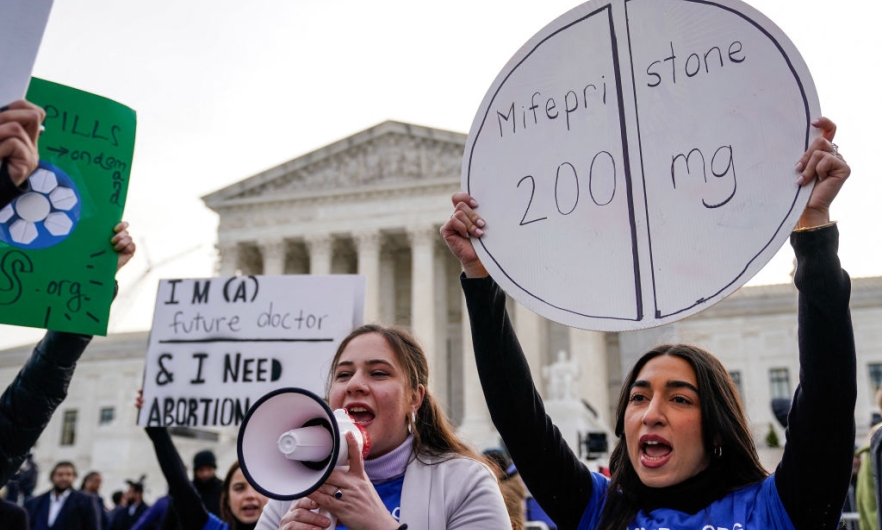The Threat to Abortion Rights You Haven’t Heard Of

Since Roe v. Wade was overturned in June 2022, ending the federal right to abortion, 14 states have banned the procedure. But even in the states that have since shored up abortion protections, those rights are not assured—thanks to a century-old law called the Comstock Act, which bans the mailing of drugs and instruments related to abortion.
The Comstock Act is a “zombie law”: Though long considered unconstitutional or unenforceable, it was never repealed and, with enough momentum, could be resuscitated and enforced.
Interpreted literally, “it could essentially shut down abortion nationwide,” explains Joanne Rosen, JD, MA, a practice professor in Health Policy and Management and an expert in reproductive law.
Rosen explains how this law threatens further erosion of abortion rights in every state, how it’s gaining legal momentum—and what can be done to stop it.
What is the Comstock Act?
The Comstock Act is an anti-obscenity law passed by Congress in 1873. It was named for its chief proponent, the “anti-vice crusader” Anthony Comstock.
The law made it a federal offense to transport by mail or other common carriers (which today would include UPS and FedEx), “obscene” materials like pornography, contraceptives, information about contraceptives, and any article, instrument, substance, device, drug, medicine, or other thing that can be used to produce an abortion.
Why hasn’t it been enforced for decades?
In the early 1970s, the provisions of the Comstock Act that made it a crime to use the mail to transport contraceptives or materials around contraceptive use were repealed.
The ban on the mailing of things designed to produce abortion is still in the Comstock Act. But in 1973, Roe v. Wade recognized a constitutionally protected right to abortion, and this prohibition hasn’t been enforced for decades. Even prior to the Roe decision, the Comstock Act had been understood to apply only to items mailed for the purposes of unlawful abortions.
What’s the latest on the Act? Where does it stand today?
In December 2022, shortly after the Dobbs decision reversed Roe and abolished the constitutional right to abortion, the Office of Legal Counsel (OLC) in the Department of Justice issued a detailed memorandum opinion that reviewed the judicial and Congressional history of the Comstock Act. The OLC concluded that, even following Dobbs, the Comstock Act does not prohibit the mailing or delivery of abortion medications (i.e., mifepristone or misoprostol) unless the sender intends that the drugs will be used unlawfully.
Now, what does this mean? Even in the strictest abortion states, where abortion is banned with very limited exceptions, there are circumstances in which terminating a pregnancy would not be illegal, such as where abortion is necessary to save a pregnant person’s life or protect their health. As well, mifepristone and misoprostol have lawful uses outside of abortion, such as in the management of miscarriage. And so, there will be situations where misoprostol and mifepristone can be used legally regardless of state abortion restrictions or bans. Consequently, senders would lack the knowledge or intent necessary to violate the Comstock Act.
Some anti-abortion advocates disagree with this opinion and are attempting to use the courts and legislation to push for a broader and more literal interpretation of the Act’s text than has been accepted before. Under this interpretation, which has been rejected by earlier courts, the Comstock Act would ban the mailing of anything that can be used to produce an abortion in all circumstances (regardless of the sender’s knowledge or intent) and in all states—including those states where abortion is permitted.
If successful, using the Comstock Act in this way would essentially constitute a nationwide abortion ban. It would cut off access to abortion pills and thereby preclude medication abortion, and would cut off access to the medical instruments and materials used by health care providers to perform procedural abortions. If providers can't get their instruments mailed by manufacturers, they’ll have no way to restock when supplies run out. This Comstock Act strategy would effectively shut down abortion not only in the 14 States that have banned it, but across all 50 states and Washington, D.C.
The law is a century old—why is it gaining new momentum now?
There are some very staunch abortion opponents whose goal is to ban abortion nationwide, and the Comstock Act is a promising vehicle for potentially achieving that through the courts.
It’s a clever strategy because, crucially, it doesn't require getting Congress to pass a new law, which is time-consuming and unlikely.
Is the strategy working?
Invoking the Comstock Act in cases concerning abortion is already a legal argument that has gained traction.
In the Food and Drug Administration v. Alliance for Hippocratic Medicine case that was argued in the Supreme Court in March—this is the challenge to the FDA’s approval of mifepristone—Justices Clarence Thomas and Samuel Alito specifically asked the attorneys whether the Comstock Act had been violated when the FDA allowed mifepristone prescriptions to be filled by mail, a decision the FDA made in 2021 during the pandemic and made permanent in 2023.
This contention gives legs to the untested argument that the Comstock Act could be a means of banning medication abortion. It doesn’t just mean that individuals would have to make an in-person visit with a provider to obtain mifepristone and misoprostol because the medications could not be mailed to them. It could potentially also mean that providers would be unable to obtain abortion pills to dispense to patients because the pills could not be mailed or shipped to them by the drugs’ manufacturers.
In Texas, one of the lawyers who crafted Senate Bill 8—the Texas Heartbeat Act, which bans abortion at six weeks—has been using the Comstock Act to create so-called sanctuary cities for the unborn. Through the passage of local ordinances, these jurisdictions ban abortion and have pledged to strictly enforce the Comstock Act to prevent the distribution of any materials that can be used to produce an abortion. These “sanctuary cities” were first created in counties that didn't have abortion clinics, so the effort was largely symbolic. But these are practice runs for a strategy that could be used nationally.
What other factors could help revive the Comstock Act?
A new president could push for a stronger enforcement of the Comstock Act, using political appointees to further the cause. Similarly, a new administration could withdraw or reverse the OLC’s memorandum opinion that concluded mifepristone and misoprostol were mailable materials under the Comstock Act. A new administration could appoint a new Postmaster General—which is a politically appointed role—who takes a strict view of the Comstock Act. In fact, back in the late 1800s, Anthony Comstock himself was named a special agent of the U.S. Postal Service and ended up being not only the chief proponent of the Comstock Act, but the chief enforcer of it.
How likely is it that resurrecting the Comstock Act would result in a nationwide abortion ban?
The possibility should be taken seriously. Dobbs has made the revival of Comstock seem much more politically tenable, as has the composition of the Supreme Court.
I've taught cases around the Comstock Act for many years and always understood these cases to be part of the country's judicial and social history. Not until 2022 did I begin to look at the Comstock Act not merely as a relic of the past, but potentially as a prologue for the future.
What can be done to counter efforts to revive the law?
The Comstock Act isn't part of the federal constitution. Rather, it is a statute and therefore far easier to amend or repeal than a constitutional provision. So, the most fail-safe way to remove the threat of its revival is for Congress to repeal it, and for voters to elect members of Congress who support the repeal of the Comstock Act.
Is there a precedent for repealing zombie laws?
Yes. One recent example is the Respect for Marriage Act, which Congress passed in 2022. It reversed the Defense of Marriage Act, which had defined a “spouse” as a person of the opposite sex and “marriage” as between a man and a woman. The Defense of Marriage Act was another zombie law—it was no longer enforceable after an earlier Supreme Court case, United States v. Windsor, invalidated it. But it was still on the books and there were concerns that it could be revived as a result of the analysis in Dobbs. Congress foreclosed this possibility by passing the Respect for Marriage Act. Similarly, Congress could repeal the Comstock Act and foreclose the possibility that it could be revived and deployed to ban abortion nationwide.
Annalies Winny is a writer and producer at the Johns Hopkins Bloomberg School of Public Health.




